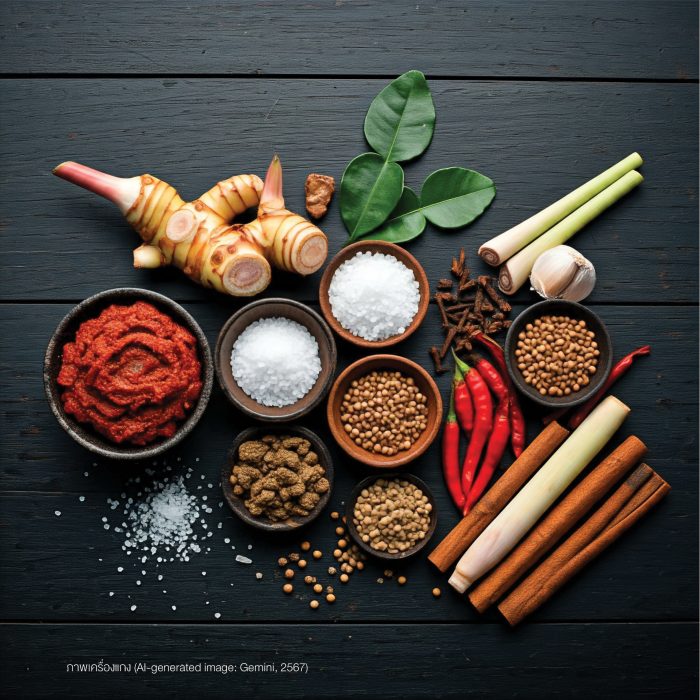
Food sets from the Muslim community in Thailand The food culture represents a harmonious integration of Thai Buddhist and Thai Muslim traditions. Islamic dietary laws play a significant role in shaping the food choices of its adherents. While it is commonly known that Muslims abstain from consuming pork, a deeper examination reveals a more intricate set of regulations. These include prohibitions against the consumption of pork and its by-products, such as lard, as well as blood, insects, reptiles, and any food or beverages containing alcohol. To promote understanding, the “Halal” symbol has been established as a recognizable marker for individuals of other religious backgrounds, ensuring they can easily identify Halal-compliant products. For Muslims, this symbol also serves to reassure them of the food’s adherence to Islamic dietary laws. Permissible animals for consumption include cattle, goats, sheep, chickens, and various aquatic creatures, such as shrimp, shellfish, crabs, fish, and other sea animals. Beyond meat, a wide range of raw materials, such as bread, roti, and rice, are also classified as Halal. Thai people have long been familiar with Muslim-inspired dishes, such as Khao Mok Gai, which draws influence from Middle Eastern cuisine. This influence is evident in its appearance as “Khao Hung Prung Yang Thet” in the royal poem “Khap He Ruea Chom Khrueang Khao Wan” during the reign of King Rama II. The term “Khaek Thet,” referring to Persia, continued to be used during the reign of King Rama V. Although Khao Hung Prung Yang Thet remained a popular royal dish, it was mistakenly referred to as “Khao Bu Ree.” The recipe for Khao Bu Ree subsequently appeared in Thailand’s first cookbook, “Mae Krua Hua Pak.“
Khao Bu Ree (Kabuli Rice in original Persian dialect) is frequently mistaken for biryani rice, though the cooking techniques for these two dishes differ significantly. The term “Kabuli” is derived from a distortion of the Persian rice-cooking method known as Pulao. This method involves simmering the rice, allowing it to slowly absorb the liquid from the stew, which imparts a deep and rich flavor to the rice. The cooking process begins with preparing a rich stew or soup, and the rice is then cooked directly in the flavorful broth. As the rice slowly absorbs the liquid, it takes on the deep flavors of the stew, continuing until all the water evaporates. This technique imparts a rich, savory taste to the rice throughout the cooking process. In contrast, biryani rice is typically prepared by draining the water after cooking. Kabuli rice holds significant importance in Muslim cuisine, frequently accompanying dishes like massaman curry. It is commonly enjoyed with sides such as roti, bread, or croissants, along with Ajard (pickled vegetables) to provide a refreshing contrast. Additionally, seasonal fruits or pineapple in syrup are often included to enhance the flavor of the savory dishes, creating a more balanced meal. The origins of the Halal food discussed above trace back to desert regions, where diets traditionally emphasize meats such as chicken, beef, or lamb, commonly featured in dishes like massaman curry. This cuisine is characterized by the use of bold and aromatic spices, a defining feature of its flavor. Massaman curry, in particular, is influenced by the Tamil culture of South India, from where it traveled through Malaya and into southern Thailand. The dish’s uniqueness lies in its blend of Indian spices with local Thai herbs such as galangal, lemongrass, and Kaffir lime peel, resulting in a distinctive flavor that is rich, spicy, and aromatic.
As appeared in the poem Kap He Ruea Chom Khrueang Khao Wan, composed by King Rama II, massaman curry is narrated as “a darling of the eyes, fragrant with cumin and a spicy flavor.” Often dubbed the “King of Curry Pastes,” massaman has earned international recognition, consistently ranked as one of the most delicious dishes in the world for many generations. It is traditionally served with rice, roti, or bread, accompanied by pickled vegetables (Ajard), which balance the richness of the curry and introduce a refreshing sour note to the meal.
Ajard is a key side dish in Thai cuisine, particularly valued for its ability to cut through the richness of spicy or oily dishes, reducing greasiness and enhancing the meal’s balance. While Ajard is commonly made with cucumbers and shallots, it can be adapted to include a variety of pickled vegetables, creating diverse flavors and aromas. The choice of vegetables often depends on locally available ingredients, similar to the Malay tradition of pickling vegetables in a mixture of vinegar, sugar, and salt. This process not only enhances the flavor but also reflects traditional wisdom in food preservation and preparation.
